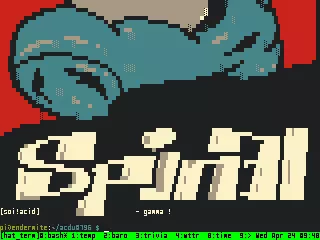This is a Pi Zero W 2 and the Pimoroni Display HAT Mini running hat_term.
- terminal emulator supporting 16, 256 and 24bit colors of foreground/background, underline, reverse and bold
- miniwi BDF font (with a few additional custom qrcode glyphs) supporting line drawing characters, drawille
- qrunicode utility to display "high resolution" codes using custom glyphs
- runs tmux, used to connect to a session to remote control the display
- use simple shell scripts to output whatever you like
- 80 columns * 30 rows on a 1.3" on the Pimoroni Display HAT Mini
- buttons switch tmux window
apt install tmux
pip install -r requirements.txtIncludes a systemd service file to connect the display to tmux. Make sure you edit hat_term.service to point to hat_term.py. It also includes a terminfo file to help with ensuring 24bit colours work.
tic hat_term.ti
sudo cp hat_term.service /etc/systemd/system
sudo systemctl enable hat_term.service
systemctl start hat_term.serviceInclude this in your .bashrc to autorun tmux on login and relaunch if it gets disconnected.
if [[ $(tty) == "/dev/tty1" ]] && [[ -z "$TMUX" ]]; then
while true; do
tmux new-session -A -s "hat_term"
done
fi Then get the pi to auto login the pi user via raspi-config
Choose option 3: Boot Options
Choose option B2: Console Autologin
Select Finish, and reboot the Raspberry Pi.
This will start a session running in the console tty, so that a keyboard and display connected to HDMI will control and mirror hat_term.
For 24bit color support, you'll need this in your .tmux.conf:
set -g default-terminal "hat_term"
set -g window-size smallest
set-option -ga terminal-overrides ",hat_term:Tc"
Manually run it with ./hat_term.py. Then connect to the tmux session with tmux new-session -A -s "hat_term"
Color definitions, default is set to gruvbox.
A forked version on the excellent miniwi font is included. It includes custom glyphs that are in the unused ee00:eeff range of unicode. qrunicode converts a qrcode matrix to these glyphs to fit more bits on the screen than the traditional block/half block glyphs.
pip install qrcodeusage: qrunicode.py [-h] [--reverse] [FILE [FILE ...]]
Print qrcodes using custom miniwi-qrunicode BDF font
positional arguments:
FILE files to read, if empty, stdin is used
optional arguments:
-h, --help show this help message and exit
--reverse reverse qrcode colors

